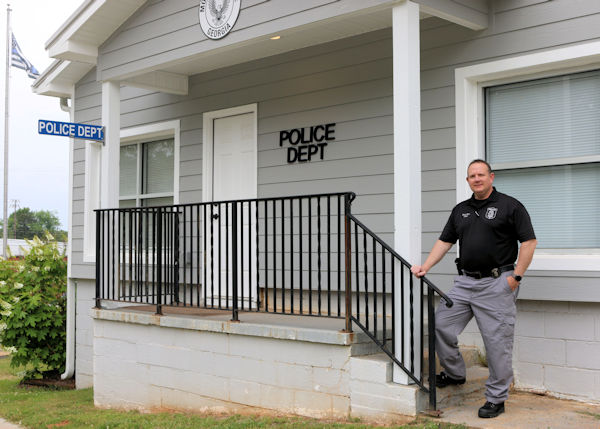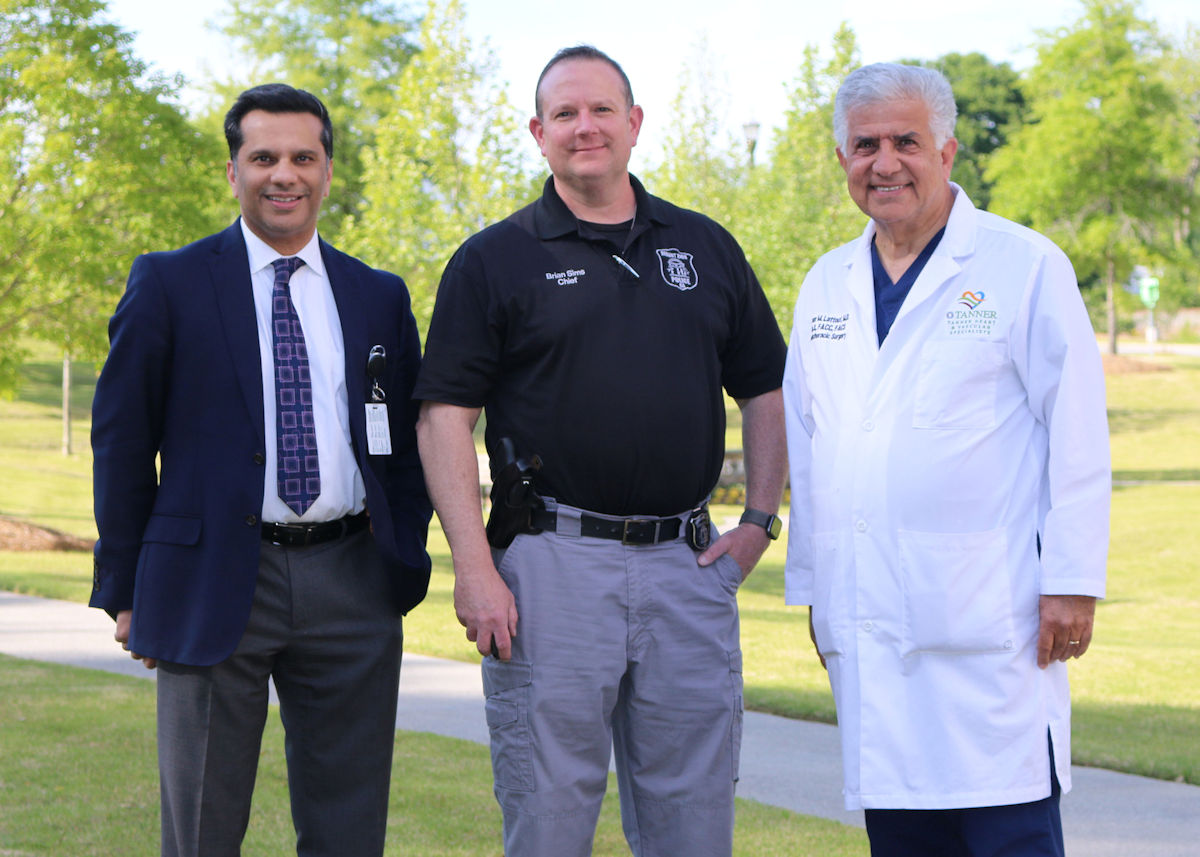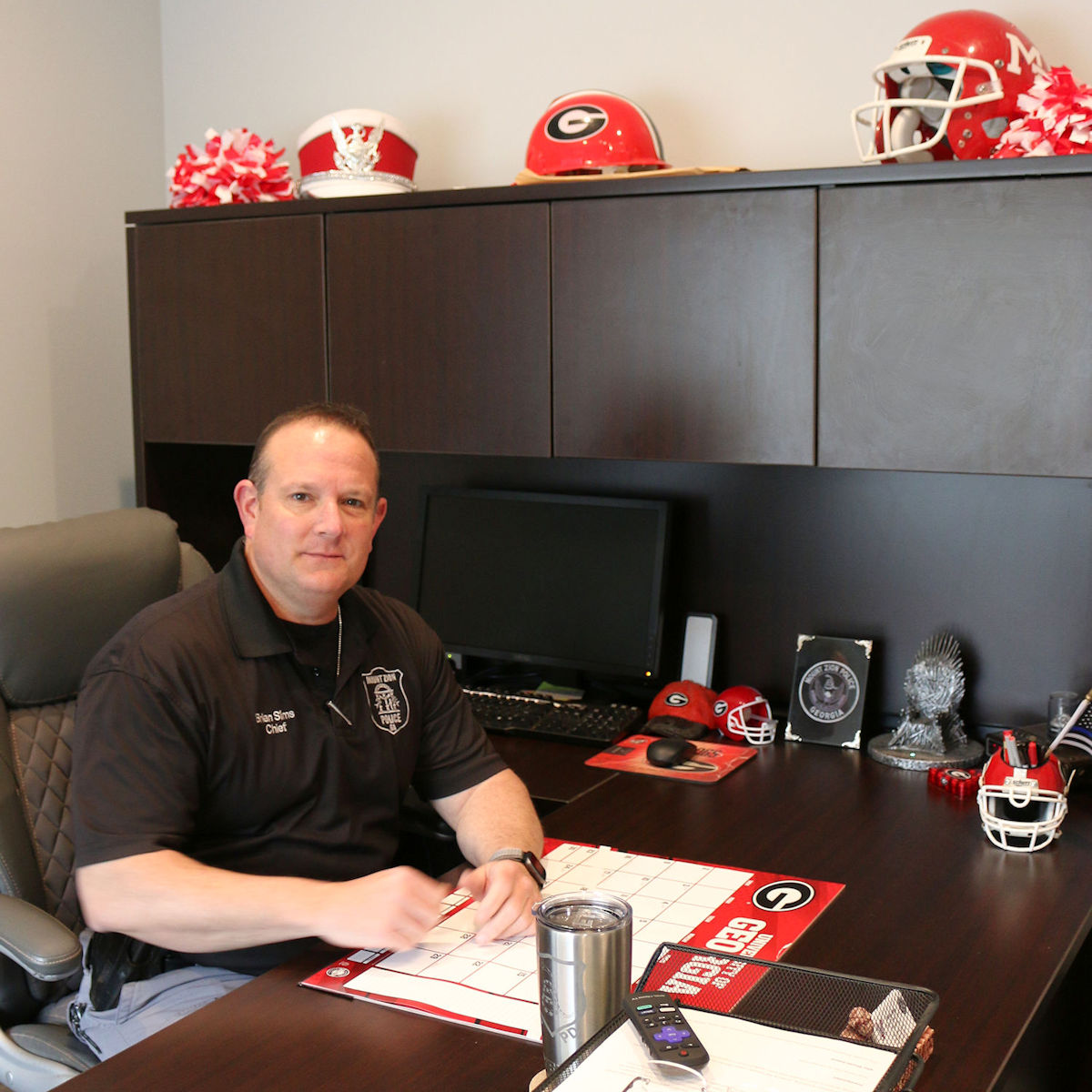 When Brian Sims, chief of police for Mount Zion, first experienced a little discomfort in his chest during a workout last September, he didn’t worry about it. After all, he was fairly fit and he was only 50.
When Brian Sims, chief of police for Mount Zion, first experienced a little discomfort in his chest during a workout last September, he didn’t worry about it. After all, he was fairly fit and he was only 50.
He was an unlikely candidate to be Tanner’s first open-heart surgery patient.
Working out and staying in shape was ingrained in him with his years on the force.
Sims had just retired as a sergeant with the Carroll County Sheriff’s Office in 2020, while staying on with Mount Zion in a role he’d also held since 1996. Fitness was a way of life.
When that discomfort didn’t immediately go away, Sims did what most people do in the age of social media: he polled his friends for advice.
Someone suggested that he reach out to Tanner Heart & Vascular Specialists for an appointment with interventional cardiologist Shazib Khawaja, MD — just to be sure. Although offered an earlier appointment with another cardiologist, Sims chose to wait for an appointment with Dr. Khawaja in January — though he now regrets not listening to his body and taking the earlier appointment.
Between September and January, Sims kept going to the gym once or twice a day while also going about his life as a busy police chief and citizen involved in the community.
He wasn’t too worried because “it didn’t seem that bad — not a real pain, per se.”
“If I felt any discomfort during a workout, I’d just sit down for a minute or two and wait for it to go away, then finish my workout,” said Sims. “I just felt like maybe I’d let myself slide and was a little out of shape.”
When Sims finally went to his appointment with Dr. Khawaja and did a stress test, his results came back as abnormal.
Sims was immediately admitted to Tanner Medical Center/Carrollton. A quick heart catheter procedure revealed that he would either need stents in multiple arteries — or heart bypass surgery.
“Age 50 is considered to be middle age, but heart disease happens at that age and even earlier,” said Dr. Khawaja. “It’s great that Mr. Sims had had a healthy lifestyle, but heart disease can happen despite that. He had some symptoms that he didn’t think were cardiac-related before his appointment but turned out to be. In his case, bypass surgery was the best approach for him.”
Sims admits he was completely unprepared for his first conversation with Dr. Khawaja about his stress test results — mostly because he had always exercised and made healthy food choices. When he learned the extent of his heart issues and that he had two options — angioplasty with multiple stents or quadruple bypass surgery — Sims struggled to make sense of what was happening.
“I was overwhelmed emotionally and maybe a little bit physically, too. Most people would look at me and think I was the last person who would need this type of surgery,” said Sims. “From my perspective and my family’s and friends’ perspectives, it was unbelievable that I was in this situation. I went in for a stress test and ended up calling my family and telling them I was being admitted.”
Sims soon met cardiothoracic surgeon Omar Lattouf, MD. During the consultation, Sims learned way more than he’d ever imagined learning about the human heart and his own heart’s condition: fairly severe four-vessel coronary artery disease with extensive blockages. Dr. Lattouf also described exactly what happened during a coronary artery bypass graft (CABG) surgery — and it was a lot for Sims and his family to think about.
“There was a lot of consultation,” said Sims. “I had the option to either do stents or the bypass. I’d come up with questions. My family came up with questions, too. And the next time I saw Dr. Khawaja or Dr. Lattouf, they would answer. Dr. Lattouf’s staff would draw on the board and provide visuals. At first, I was leaning toward just doing the stents. The recovery isn’t as long. But after many consultations with both doctors and their staff, I decided to go with the bypass surgery.”
 Once that decision was made, Sims was scheduled for surgery on Jan. 24 — only seven days following his stress test. For the surgery, Sims was in the hands of Dr. Lattouf and his team.
Once that decision was made, Sims was scheduled for surgery on Jan. 24 — only seven days following his stress test. For the surgery, Sims was in the hands of Dr. Lattouf and his team.
“Being a younger man, otherwise very healthy, I performed an advanced type of coronary artery revascularization on Mr. Sims,” said Dr. Lattouf. “I did three arterial grafts and one vein graft for a four-vessel bypass. We used sections of his right and left anterior thoracic arteries, a left radial artery from his left forearm, and one piece of vein from a leg. His immediate recovery following the surgery was very straightforward and uncomplicated.”
Dr. Lattouf (pictured to the right of Sims) and Dr. Khawaja (pictured left) are both very pleased with Sims’ recovery, now more than 12 weeks later.
“I saw him in the clinic last week. He looks great. He’s regained his energy and is up and about, moving well and on his way to make a full recovery,” said Dr. Lattouf.
From Sims’ perspective, his recovery has been more of a “rollercoaster ride,” but he was prepared for that by the team.
“Where the bones are still on the mend in my chest, there’s a soreness and nagging ache that may not go away completely for another couple of months. But all of my incisions where they harvested the needed arteries and veins are healed,” said Sims. “I can walk well. Some days I wake up and feel sore in places that I don’t know why. Other days, I wake up and think, ‘man, I feel good all over.’ Some days I’m full of energy and some I just want to go back to bed. But I’ve been told that what I’m experiencing is normal. It’s the body healing itself.”
Sims was anxious to begin physical therapy, but he had to wait a little while following surgery for that.
“I’ve lost 34 pounds. The weight loss has been hard for me to wrap my head around,” said Sims. “Before the surgery, I went to the gym a lot, so I had a muscular build. Most of that is gone. It will take some time to build it back. Some of that is due to my appetite, which is slowly coming back. Plus, I’m always outside walking. They are fine with me walking and I do a good bit of that. That burns calories I’m probably not fully replacing. I will be on a special cardiac diet eventually. Right now, they just want me to eat something.”
According to Dr. Lattouf, everything that Sims has experienced is normal.
“Every day after coronary bypass surgery is usually a better day than the one before. It takes about 90 days for the breastbone to heal completely,” said Dr. Lattouf. “Most patients feel 80% to 90% by six weeks. By three months, most of them have other life issues to deal with. They are no longer thinking about the operation, aches and pains. The challenges and pains of the operation become remote.”
Interestingly, according to Dr. Lattouf, patients differ in the pace of their recoveries, and that’s not always easy to explain.
“Right after surgery, some patients hardly take any pain medication and are well-spirited. Different people have a different pain tolerance and different energy levels. Patients who need heart surgery come from different backgrounds. It’s hard to predict,” said Dr. Lattouf. “Sometimes someone who is petite and doesn’t look strong bounces back faster than someone who looks fit. We do not have one yardstick for everyone. We see our patients for as long as they need us.”
Dr. Lattouf said most open-heart surgery patients’ wounds heal and their pains resolve by the 30-day mark. At that point, they are ready to resume normal activities and go back to work — with pacing depending on the type of jobs they do and how much manual labor is involved. Most will also begin cardiac rehab at that time.
“That’s when we like for them to go back to see their cardiologist, who will take over their care and rehab. If the cardiologist feels the patient needs to come back to see us, then we are happy to see them,” said Dr. Lattouf. “Once we operate on them, we tell our patients that they are members of our families for life. They have a lifelong ‘membership’ with us.”
 Sims also feels that kinship to his heart team.
Sims also feels that kinship to his heart team.
“I would not be doing them justice if I didn’t say that the staff of the heart unit — where I stayed for a week before my surgery — is wonderful. They were patient with my questions. Their bedside manner was amazing,” said Sims. “And after my surgery, the ICU staff was marvelous. In the ICU, any time there was something difficult, they were at my side helping me through it. Also, Dr. Lattouf is one of the best, and Cody and Gene on his staff are two of the best as well. I could rave about all of the people I got to know during my two weeks in the hospital, but I don’t want to leave anyone out.”
Just 14 weeks after that first coronary bypass surgery performed on Sims, the team has performed 23 open-heart surgeries — plus 22 thoracic surgeries, an aortic valve replacement and a several additional types of procedures.
“We are pleased that our patients are doing very well and making great progress. It has been busy and very pleasant. We are delighted with the team that we have assembled,” said Dr. Lattouf.
He is equally as amazed and pleased by Tanner Health System.
“Tanner has exceeded any expectations that I had. It’s an amazing institution with amazing people,” said Dr. Lattouf. “The people here are very special. They’re hard workers who are dedicated and eager to learn. And their work comes from the heart. It’s like working with your best friends.”
Sims’ recovery from his quadruple bypass — aided by his new best friends with Tanner Heart Care — continues. He has begun cardiac rehab and is back at work with some restrictions. And when the mood strikes and he has time, he heads down to a pond on his property to fish, relax and let his heart and chest continue to heal. Life looks sweeter every day.